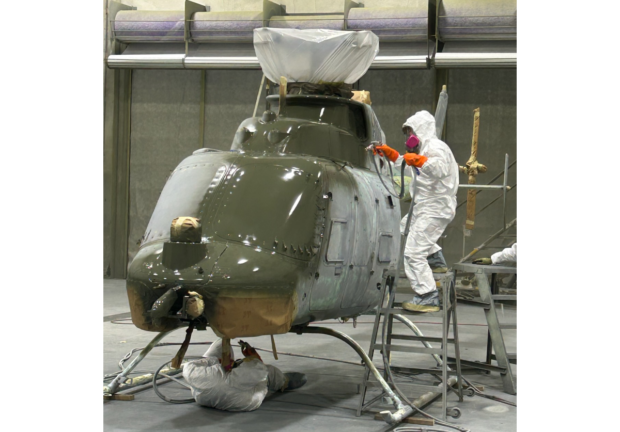The MQ-8C Fire Scout, a variant of the MQ-8B, is an unmanned aerial vehicle used for expeditionary operations aboard ships. The Navy’s only unmanned helicopter, which can be deployable from land or sea, provides target-acquisition, real-time intelligence, surveillance, and reconnaissance to the men and women of the US Navy and Marine Corps.
In 2015, Naval Air Systems Command designated Fleet Readiness Center Southwest (FRCSW) as the location for all maintenance and repair workload on the MQ-8 airframe. This year, FRCSW became the first depot to do a full paint scheme for an MQ-8C. The paint and strip process was meticulously completed by FRCSW artisans and is crucial for the aircraft’s longevity and operational readiness.
Surface preparation is key. First the aircraft’s surface is cleaned and stripped of any existing paint or coatings using methods like sanding or media blasting. Another option for cleaning the surface is to use a chemical stripping process, however, this method can be environmentally hazardous and pose risks to the health of the employee. In order to avoid those concerns, the FRCSW artisans use a hand sanding method. The hand sanding method also lowers the likelihood for rework and damage including corrosion and is a healthier method for the aircraft.
After surface preparation is completed, a primer coat is applied to enhance adhesion and corrosion resistance. The base coat is then applied, which includes the color and any markings or insignias desired by the squadron. This can be done using spray guns or specialized painting techniques. A clear protected layer is applied over the base coat to provide additional durability. Throughout the process, masking techniques are used to ensure precise application and prevent paint from reaching areas where it shouldn’t be.
The strip and paint process is not solely for aesthetics. It is essential to the MQ-8C’s longevity and operational readiness for several reasons. It helps maintain the aircraft’s structural integrity, allows for detailed inspections, repairs, and maintenance of the aircraft’s surfaces. It also contributes to the overall longevity and serviceability of the aircraft. In addition, MQ-8C aircraft operate in various environments, including high humidity, saltwater exposure, and extreme temperatures. The paint system acts as a protective barrier, shielding the aircraft’s metal surfaces from corrosion caused by moisture and other corrosive agents.
Moreover, military aircraft often require specific camouflage patterns or colors to blend with their operational environment, such as forests, deserts, or open ocean. The paint job helps to make the aircraft less visible and harder to detect by enemy forces. Proper strip and paint procedures ensure that the aircraft displays the appropriate national insignias, identification codes, unit markings, and other required visual cues. These markings facilitate quick identification by friendly forces and aid in effective communication during military operations. For heat management, some specialized coatings or heat-reflective paints can be applied to aircraft surfaces to manage heat absorption, particularly for areas exposed to high temperatures from engines, exhaust, or other sources.
This helps prevent excessive heat buildup and potential damage to sensitive components. By ensuring proper strip and paint procedures, military aircraft can maintain their operational readiness, protect against corrosion, enhance camouflage, facilitate identification, manage heat, and extend their service life—all crucial factors for military effectiveness and safety.
In charge of the process for planning, labor estimates, material and tooling requirements, Jay Noblin and Jeremy Gates, are two key leaders that spearheaded the successful enhancement and preservation of the MQ-8C at FRCSW.
“It was a good team effort between engineers and artisans to complete the MQ-8C in what we all believe is a very timely manner,” says Gates.
“We have been lucky to have good leadership that knows about this process and they’re taking what they learned from one aircraft variant to the next,” Noblin says.
Described by Noblin as being “leaders in this rework”, the command successfully completed the full paint scheme of the MQ-8C in just two weeks and at a cost lower than any other organization. As the first depot to complete the full paint scheme for the MQ-8C, FRCSW set the standard and is looking forward to completing future naval aviation advancements and solutions.

